James Harper (publisher)
| James Harper | |
|---|---|
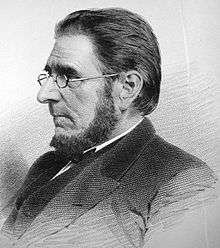 Engraving of James Harper by Frederick Halpin. The photograph from which this portrait was drawn was taken just 2 days before Harper's death in 1869. | |
| 65th Mayor of New York City | |
|
In office 1844–1845 | |
| Preceded by | Robert Morris |
| Succeeded by | William F. Havemeyer |
| Personal details | |
| Born |
April 13, 1795 Elmhurst, Queens |
| Died |
March 27, 1869 (aged 73) New York City, New York |
| Profession | publisher |
James Harper (April 13, 1795 – March 27, 1869), was an American publisher and politician in the early-to-mid 19th century. James was the eldest of four sons born to Joseph Henry Harper, (1750-1838), a farmer, carpenter, and storekeeper, and Elizabeth Kolyer, daughter of Jacobus Kolyer (1749-1819) and Jane Miller.[1]
Childhood and starting in business
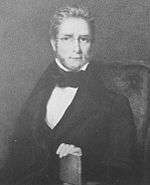
Harper was born in Newtown, New York. As a boy, he read The Autobiography of Benjamin Franklin, and decided that he would like to pursue a career as a printer because of Franklin's success in the field. An apprenticeship was subsequently arranged with a family friend, Abraham Paul, who was a partner in the New York printshop of Paul & Thomas. James' younger brother John (22 January 1797 – 22 April 1875)[2] began his printing apprenticeship at another printer in the city within two years. In 1817 the two brothers had learned what they could of the profession and felt that they were ready to try their hand at running their own printing business. In 1817 the brothers founded J. & J. Harper in New York at the corner of Dover and Front streets; James was nearly 22 years old and John was 20. The business was supported by a loan from their father to purchase two Rampage printing presses, some typesetting stock, and simple binding equipment.
In 1817 Paul received an order from the prominent New York bookseller Evert Duyckinck for 2,000 copies of an English translation of Seneca's Morals ("Seneca's morals by way of abstract", translated by Roger L'Estrange and first published in England in 1678.) Paul gave the order to his young apprentices, James and John, who did the printing, working with their younger brothers Joseph Wesley (25 December 1801 – 14 February 1870)[2] and Fletcher (31 January 1806 – 29 May 1877)[2] who aided in setting type, and issued it under the imprint J. & J. Harper. This book was followed in 1818 with an edition of John Locke's An Essay Concerning Human Understanding (1818), which they issued under the J. & J. Harper imprint as publisher rather than merely printer.
A description of James from this time can be found in Glyndon G. van Deusen's 1944 essay on Edward Thurlow Weed, an acquaintance and fellow printer:
- Harper was a big fellow with a prejudice against liquor, but with such a jovial nature that he became known among the hard drinking printers as "the teetotaler who was never sober". (Glyndon G. van Deusen, 1944)
Publishing
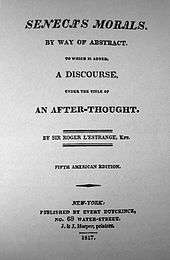
With his brother John, James founded the printer J. & J. Harper in 1817. The name was changed to Harper & Brothers in 1825 when the two other brothers, Wesley & Fletcher Harper, joined their brothers. With the name change the company also broadened their printing business to also include publishing services.
First big success was Maria Monk's Awful Disclosures (1836). Often described as the "Uncle Tom's Cabin of nativism", the book went on to sell 300,000 copies for Harper & Brothers. It was later disclosed that Theodore Dwight was the actual author of the work, though he claimed it was dictated. The book ostensibly told the story of a Canadian woman who claimed to have been a nun who had been sexually exploited in her convent. The work was published during a time of extreme anti-Catholicism in the United States, and was used by politicians and anti-Catholic activists to seed discontent and incite riots. In the words of the historian Ray Allen Billington, it became "the most influential single work of anti-Catholic propaganda in America's history".
Within eight years of the publication of Awful Disclosures James Harper was elected mayor of New York, running on a Know-Nothing, Nativist platform of anti-Catholicism and anti-immigration. Ms. Monk's book had a brief revival in the 1960s during John F. Kennedy's run for the Presidency of the United States.
Harper & Brothers became Harper & Row in 1962 when the firm merged with Row, Petersen & Co. Following News Corporation's acquisition of Harper & Row in 1987, the company was merged with William Collins publishers in 1990, resulting in its current name, HarperCollins. HarperCollins had sales of US$1,162 million in 2004 and employs over 3,000 people worldwide.
Politics
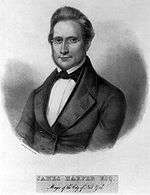
In 1844 James Harper was elected American Republican Party mayor of New York for one-year term, defeating Locofoco Party candidate Jonathan I. Coddington and Whig Morris Franklin. James won the election by 4,316 votes.
He reformed the city police force and established the first municipal police force in 1844, based on planning undertaken earlier by Peter Cooper. In-fighting between the city alderman delayed full implementation of the reform plan, and Harper was only able to select 200 men for the force before he was ousted by voters in April 1845. He outfitted his "Harper's Police" in blue uniforms, which they felt made them targets of violence, and they lobbied successfully to wear street clothes. His successor William Havemeyer continued to reform the police force and was successful in expanding the force to 800 and beginning the establishment of station houses.
Harper banished free-roaming pigs from the streets of New York, and began work on establishing a citywide sanitation system. He was subsequently put forward for the governorship of the state; but he preferred to conduct the business of his firm rather than enter public life.[2]
Residences
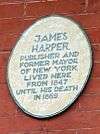
Lived at 50 Rose Street while he was mayor.
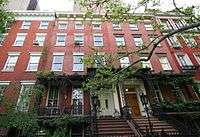
Lived at No. 4 Gramercy Park West from 1847 until his death in 1869. Greek Revival, architect Alexander Jackson Davis.
NYC legacy
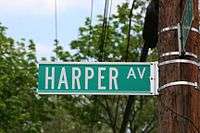
Interment at Green-Wood Cemetery, Brooklyn, N.Y.
Served as a Vassar trustee until his death in 1869.
Harper Avenue in the Bronx, New York is named in his honor. Harper Avenue is located two blocks from the terminus of the number 5 line in the New York City subway system—the Dyre Avenue stop.
References
- ↑ James Riker, Annals of Newtown, New York, p. 40
- 1 2 3 4
 Wilson, James Grant; Fiske, John, eds. (1900). "Harper, James". Appletons' Cyclopædia of American Biography. New York: D. Appleton.
Wilson, James Grant; Fiske, John, eds. (1900). "Harper, James". Appletons' Cyclopædia of American Biography. New York: D. Appleton.